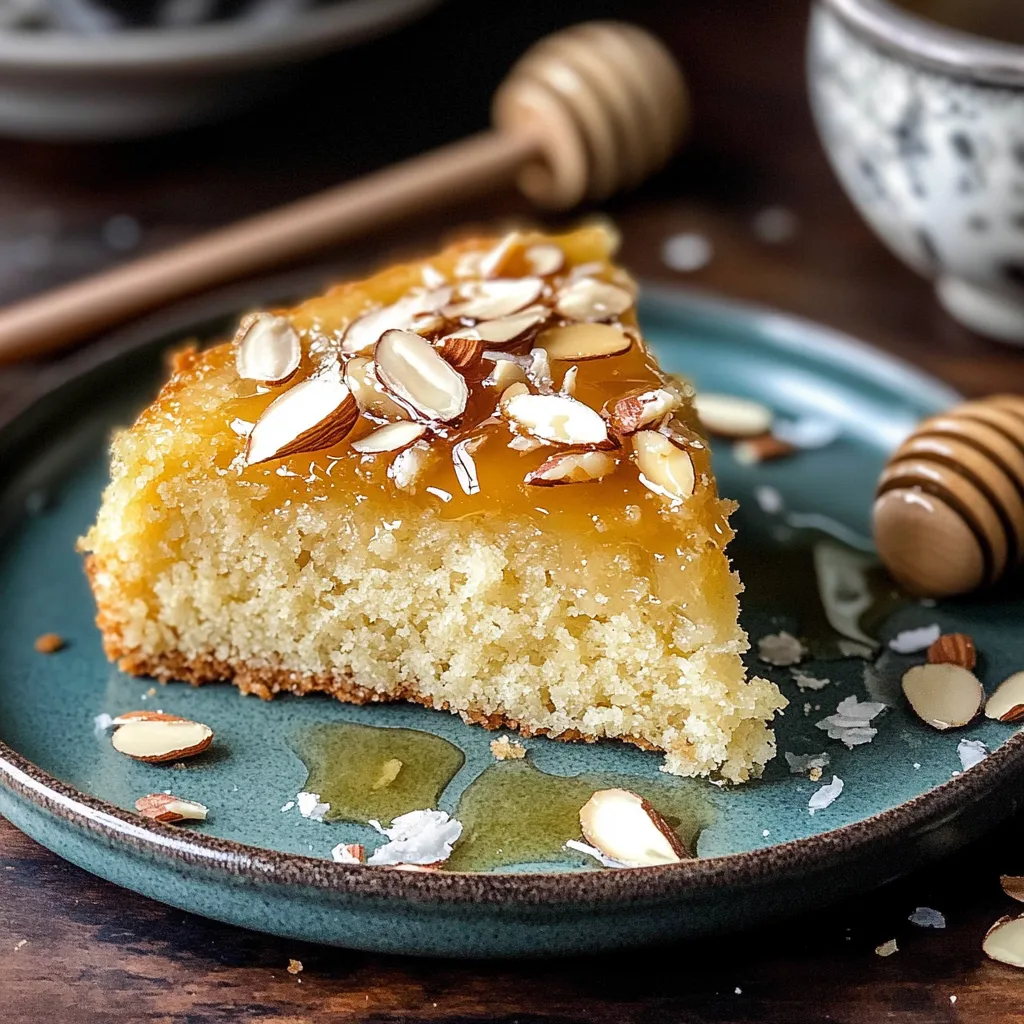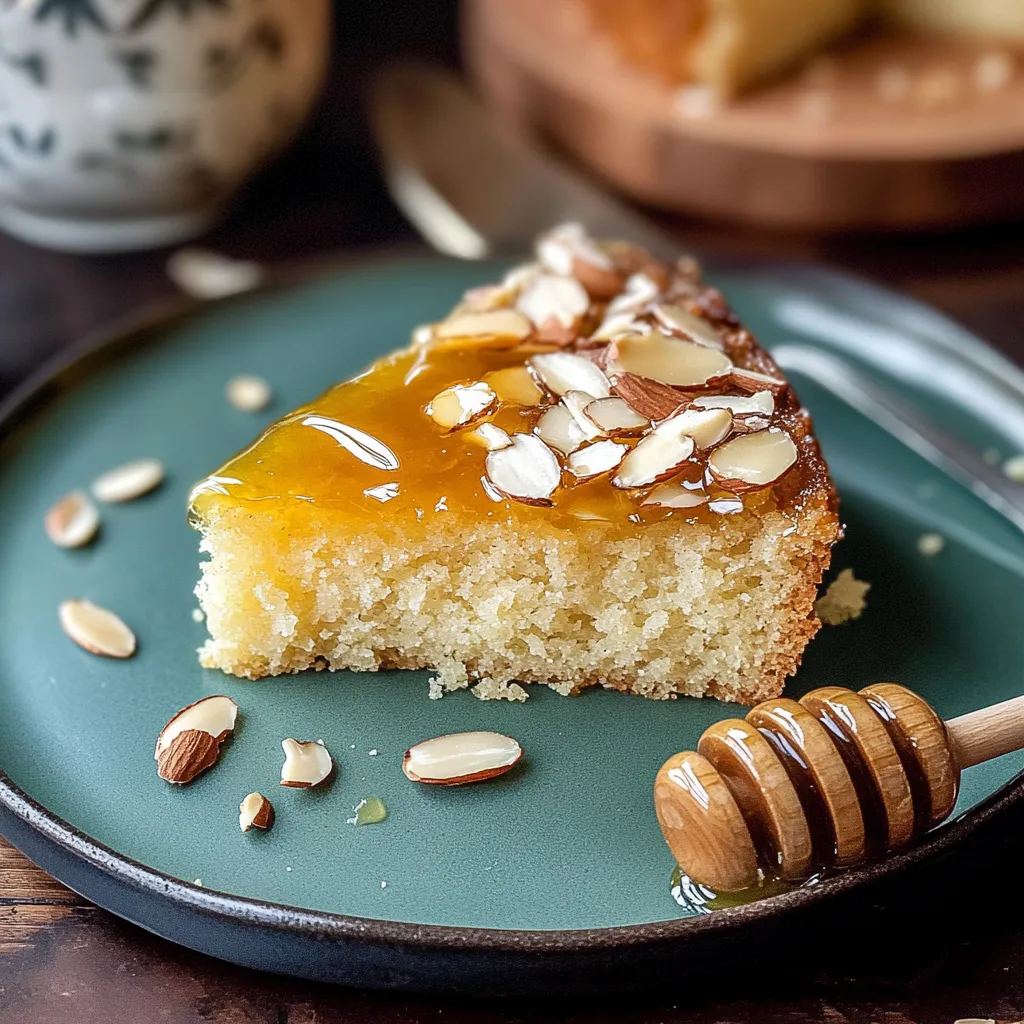 Pin it
Pin it
Soaked honey almond cake combines the nutty richness of almond flour with the floral sweetness of honey in a tender, moist dessert that melts in your mouth with each bite. This exquisite cake gets its incredibly soft texture from a honey simple syrup bath that infuses intense flavor while ensuring every crumb remains deliciously moist. I discovered this technique after experimenting with traditional Mediterranean desserts, and it's since become my go-to recipe when I want to impress guests without spending hours in the kitchen.
I first served this cake at an impromptu dinner party when I needed something elegant yet unfussy. My friend Sarah, who typically declines dessert, asked for seconds and then requested the recipe before leaving. What I love most about this cake is how the honey flavor deepens overnight, making it perfect for preparing ahead when hosting. The sliced almonds on top provide just enough textural contrast against the incredibly soft interior.
Simple Staples
- Room temperature eggs: Essential for proper emulsification and aeration in the batter; cold eggs will cause the butter to seize
- Unsalted butter: Creates a tender crumb and rich flavor foundation; ensure it's properly softened for smooth incorporation
- Granulated sugar: Provides structure while balancing the honey's distinct sweetness
- All-purpose flour: Gives necessary structure to the delicate cake; use a gluten-free blend if needed for dietary restrictions
- Fine almond flour: Not to be confused with coarser almond meal; provides the cake's signature tender texture and nutty flavor
- Pure almond extract: Enhances the natural almond notes; a little goes a long way in creating depth
- High-quality honey: Select a flavorful variety like orange blossom or wildflower since it's the star ingredient
- Sliced almonds: Create a beautiful topping with gentle crunch while reinforcing the almond flavor
My grandmother always said that honey desserts taste of the flowers the bees visited, and she was right. I've made this cake with everything from lavender honey to buckwheat honey, each creating a distinctly different character. For summer gatherings, I prefer lighter, floral honeys that complement fresh berries, while deeper varieties like chestnut honey create a more complex winter dessert.
Sweet Success
Prepare Your Pan
- Lining the Pan:
- Line an 8-inch round cake pan with parchment paper, creating a strip that extends up opposite sides like handles. Place a parchment round on the bottom. This preparation is crucial since the finished cake will be too delicate to invert. Butter the parchment and sides thoroughly to ensure easy removal after baking.
Create The Foundation
- Creaming Butter and Sugar:
- In a large bowl, cream together softened butter and sugar until smooth and light, about 2 minutes by hand or 1 minute with an electric mixer. The mixture should be pale and fluffy, but not overly aerated as in some cake recipes. This moderate creaming creates the perfect density to absorb the honey syrup.
Build Structure
- Adding Eggs:
- Add room temperature eggs one at a time, beating well after each addition until the mixture becomes light and fluffy with a pale yellow color. If the mixture looks curdled, it's likely your eggs were too cold. Don't panic—continue mixing and it should come together, though the final texture may be slightly affected.
Blend Dry Ingredients
- Combining Flour and Baking Powder:
- Sift together all-purpose flour and baking powder, then gently fold into the batter until just combined. Overmixing at this stage will develop gluten and create a tough cake, so use a light hand with your spatula, stopping as soon as no dry streaks remain visible.
Introduce Almond Elements
- Adding Almond Flour and Extract:
- Fold in the fine almond flour by hand using a gentle cutting motion until fully incorporated. Add almond extract and stir just until evenly distributed. The batter should be thick but spreadable, with a consistency similar to frosting. Transfer to your prepared pan, spreading evenly to the edges.
Top With Texture
- Adding Sliced Almonds:
- Sprinkle sliced almonds evenly over the surface of the batter, pressing them lightly so they adhere during baking but remain visible. This creates both visual appeal and a pleasant textural contrast to the soft cake interior. Bake in a preheated 350°F oven until the center springs back when lightly touched and the edges pull away from the pan slightly.
 Pin it
Pin it
My first attempt at this cake was nearly ruined when I tried to remove it from the pan while it was still hot. The delicate, syrup-soaked texture needs time to set up properly. Now I always let it cool completely in the pan before attempting to lift it out using the parchment handles. Patience rewards with perfect slices rather than a crumbled mess.
Serving Suggestions
This versatile cake shines in multiple presentations depending on the occasion. For casual family desserts, serve slightly warm with a dollop of lightly whipped cream and a drizzle of additional honey. When hosting a more formal dinner, try topping with fresh seasonal berries—the slight tartness perfectly balances the cake's sweetness. During fall and winter months, transform it by serving alongside poached pears spiced with cinnamon and star anise.
Creative Variations
This adaptable recipe welcomes thoughtful variations while maintaining its essential character. Add 1 tablespoon of orange zest to the batter for a bright citrus note that enhances the honey's floral qualities. Replace the almond extract with vanilla extract and add 1/4 teaspoon of ground cardamom for a subtly spiced version. For a Mediterranean twist, sprinkle 1 tablespoon of fresh thyme leaves over the top before baking and use a bold Greek honey in the soaking syrup.
Keeping Fresh
Store this cake at room temperature under a cake dome or loosely covered with foil—plastic wrap can make it too soggy by trapping too much moisture. It will remain deliciously moist for up to three days, with many people insisting it tastes best on the second day when the honey flavor has fully permeated every crumb. Freezing isn't recommended as it compromises the delicate texture that makes this cake special.
I've been perfecting this recipe for nearly four years, making slight adjustments with each baking session. What began as an experiment has become my signature dessert, the one friends request for birthdays and special occasions. My husband, who typically prefers chocolate desserts, now requests this cake for his birthday every year. There's something magical about how this simple combination of ingredients transforms into something far greater than its parts. The way the gentle sweetness of honey permeates every bite, complemented by the subtle nuttiness of almond, creates a dessert that feels both homey and sophisticated—perfect for everything from casual Sunday suppers to elegant dinner parties.
 Pin it
Pin it
Frequently Asked Questions
- → Can I substitute regular flour for the almond flour?
- The almond flour is essential for the texture and flavor of this cake. While you could use all regular flour, the cake would lose its distinctive nutty flavor and moist texture. If needed, you could try using hazelnut flour as a substitute.
- → What's the purpose of the honey simple syrup?
- The honey simple syrup serves two important purposes: it adds moisture to keep the cake exceptionally tender, and it infuses the cake with rich honey flavor that permeates throughout as it soaks in.
- → Can I make this cake ahead of time?
- Yes! This cake actually improves with time as the syrup fully distributes. You can make it 1-2 days ahead of serving. Store it lightly covered at room temperature to maintain the best texture.
- → What does it mean to cover 'lightly' for storage?
- Unlike many baked goods that should be tightly sealed, this cake benefits from a bit of air circulation to maintain its texture. Cover with a cake dome that doesn't touch the cake, or place a sheet of parchment paper loosely over the top.
- → What are 'parchment paper rounds with slings'?
- This refers to cutting parchment paper in a circle to fit the bottom of your cake pan, with extra pieces extending up and over the sides (the 'slings'). These extensions act as handles to easily lift the cake out of the pan after baking.
- → What type of honey works best for this cake?
- Any honey you enjoy eating will work well. For a more distinctive flavor, try orange blossom, wildflower, or lavender honey. The more flavorful your honey, the more pronounced the honey taste will be in the final cake.
